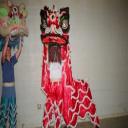Yahoo Answers is shutting down on May 4th, 2021 (Eastern Time) and the Yahoo Answers website is now in read-only mode. There will be no changes to other Yahoo properties or services, or your Yahoo account. You can find more information about the Yahoo Answers shutdown and how to download your data on this help page.
Trending News
Are the supplementary exercises of traditional martial arts not well known to none traditional martial artists?
It seems that most all (though not everyone - just the biggest majority) who is into combat sports and "modern" martial arts think all the traditional martial arts are is nothing but dancing, shadow boxing and light to no contact sparring. This, of course, couldn't be further from the truth.
How many of you who are not a traditional martial artists have knowledge about the strength training and body conditioning performed by the traditional martial arts? What are your views on them and do you think they have any significance?
Those who are traditional martial artists: where do you think the fault lies in this not being very well known? Are the supplementary training (from the makiwara to forms such as Sanchin and Iron Thread) kept too "hidden" or at least closely guarded for the advanced practitioners? And is this good or bad?
17 Answers
- LiondancerLv 71 decade agoFavorite Answer
I am answering as a traditional martial artist and having trained with Masters from Okinawa and China. I started in Okinawan Karate and we never trained in strength and body conditioning. I was a beginner and I could see my Master doing things I felt I was not being taught. I was frustrated with the training thinking I would get the same training my Master had and my Master decided to introduce some of the training. I was speechless at the resistance he got from even the highes ranking black belts and I understood why it was not being taught. These guys were too lazy to train hard. Moreover I was told I needed to slow down my training or I would hurt myself! It wasn't long before my Master gave up the training and went back to the usual watered down version but ever so often when he thought no one was looking he took me aside and showed me some of the exercises he used to do and tell me about the training he received when he was young. I do these exercises to this day. When I got into the higher ranks I found out that in Okinawa there is an association of Karate for Okinawans and one for westerners. The one for westerners often has then name Beikoku (American) added and has lower standards for the same rank than the Okinawan counterpart.
I found the same to be true once I got into the Chinese martial art. The Chinese Masters too do not train the westerners the same way they do the Chinese. My Chinese Master came flat out and said it: "They find it too hard." He would have no western students if he trained the westerners the same way he trained the Chinese. Why does he train westerners at all? We have the money and pay much more than what any Chinese person could ever pay him so he gives us what we can take.
Is it bad? Yes, I think it is. Martial Arts (I am not talking about the ability to hit hard) are less effective without conditioning, MENTALLY and physically and very few stick around long enough to get really good because they do not have the attention span and patience it takes to learn really good martial arts and most don't even understand what good martial arts is nor have they even seen it. It is not knowing how to hit hard.
- Anonymous5 years ago
Martial arts ans sport are 2 totally different concept. They by no means are equal. The 2 look different and are practiced different. Unfortunately many today do not know the difference. Many are being taught a sport and never learn the art. Therefore people with no knowledge of the arts see a weak version of a true art and gauge everyone according to their knowledge of martial arts and they don' have any knowledge. I love how pugspaw, sensei scandal, stillcrazy put it. I have nothing against those that play games. That is great for them. However, I am interested in having the knowledge and ability of self defense. I'm interested in budo. I do not even want to use the term martial with sport. The 2 does not go together. One is a game. The other is war. There is nothing better than when attacked knowing how to position yourself in a manner that the attacker can't do anything, but is exposed to everything that will stop the threat immediately. When I was a child I played tag. I don't play that childish game anymore. We used to trade punches in grade school. I don't trade punches anymore. If I hit you I mean to stop you. I do not look for a referee to say you tapped out. I'll know you are out when the lights go out and you go limp. I'll know that you surrender when I hear or feel the joint snap. I'll know you can't use that limb right now to attempt to harm me or my family.
- SteppingLv 41 decade ago
With so many good answers I can not add more other than my own experiences.
knowledge is not always guarded. It may simply be ignored for different reasons. After a while people don't know any better and the junk that is left is often called martial arts.
When younger I went to a "traditional" Okinawan karate school. The Karate taught there did not include any conditioning other than hitting a makiwara. I asked about resistance or any other type of exercise and no one truly knew anything of use. They only knew forms and hit the pad. Very SAD. One very strange occurrence was that an instructor from Okinawa came to the school and ran a seminar. As he taught the head sensei/owner of the school followed behind him changing the techniques he was teaching. Changing them to useless! Crazy right! I don't know how the Master from Okinawa tolerated this. After the seminar the guest instructor took myself and a couple others aside to work with us. Afterwards the owner/sensei of the school also pulled us aside and said "do not take his techniques too seriously. There is more to karate than hurting people" or some garbage like that. Obviously this karate school and the man who ran it never had any real interest in Karate. You can not pick and chose parts of an art to teach like you use a menu to serve lunch. One could never learn a real art in this school but there are so many like it. Instructors who never had real training or those who just chose to erase it for money or their own egotistical purposes.
When I finally found a "real" kung fu school what a difference! There are all types of training however the classes do tend to drive people away. The Instructor has told me of his original training and said few would ever tolerate it today. His classes are toned down a bit but not lacking full use of ones body and the many martial ways to develop it. He will work with you personally but guys like him are few and far between. Only after meeting this man have I had the luck to meet teachers of karate who have not "chopped up" the art. They tech methods of conditioning i think most would not even consider to be martial arts. Only because so few also teach them.
I can see how "complete" systems are lost when they are cut down to appeal to everyone. After all the truth is martial arts are hard and painful work. Real arts never get easy and when you think you are good there is always some one better. When you think you know it all something new often punches you in the face.
- ?Lv 61 decade ago
Thanks for an inner look into how instructors teach, Lion. Very interesting.
I see it as a 3 or 4 things going on at once.
1. Learning the components of fighting.
2. Teaching the components of fighting.
3. Learning the purpose and design of training methodologies.
4. Teaching the purpose and design of training methodologies.
So a person that can do 1 and 2, still may not be able to communicate well enough concerning a different system for there to be any cross trade or understanding going on.
For individuals learning MMA, but not teaching anything, they are in even more difficult of a position when it comes to talking about different training methodologies.
I see it as a natural bell curve. The greater the number of martial artists, the greater the number of lemons or beginners. It used to be, as one hypothetical example, if you had a group of 100 people, 5 would be the masters, 20 the cadre instructors, and 75 the intermediate to beginners. Out of them all, only 1 or 2 would be the real fighters and leaders.
The thing is, it's impossible to increase the number of cadre instructors if the student body blows up in numbers too fast. So while MMA has made MA more popular than otherwise, it has the downside of increasing the base too fast without increasing the cadre instructors needed to improve the level of the beginners. Thus you get more beginners, stuck at more places.
There are plenty of Westernized training systems which do work when it comes to learning Eastern Martial Arts. The issue is you have to adapt it both ways almost. This runs into a specialization issue because the number of people who can construct a training system, is far less than the number of people who can teach a martial art for real.
- ?Lv 71 decade ago
A very good question and I do emphasize some of these with my students and fighters. Ones especially for the hips and lower back and wrists that I have learned through martial arts and Yoga I teach and have found particularly useful for helping to avoid problems and injuries in my training. I also find it interesting to note that some of these exercises for the hands and wrist are also what therapists recommend today for helping to combat carpal tunnel syndrome.
I do think such things are more heavily emphasized in the Chinese martial arts than in the Japanese martial arts which are what I study. Probably many practitioners today are not taught some of the old training methods and exercises by their instructors because many of those instructors were not taught such things themselves. That and as time and generations have gone on a little of this has probably been lost with each successive generation I suspect.
As for techniques themselves I have observed that being a westerner has allot to do with this and did occasionally encounter this when studying in Japan. I think it is both a cultural thing as well as a certain amount of bias more than anything else.
- Shiro KumaLv 61 decade ago
To add a bit to Liondancer's answer...
Traditional supplementary exercises aren't always hidden per se, but are either misunderstood or people simply expect too much of them. In aikido, for instance, with all the emphasis on "ki" and internal strength, people are often disappointed when conditioning exercises simply mean old-fashioned, plain, physical hard work.
Put simply, people expect that these exotic/mysterious/mystical arts from the East rely on some sort of esoteric training regimen that doesn't require hard work. In fact, some of the traditional conditioning drills in classical arts aren't really "efficient" from a scientific perspective; compared with the the focus of modern sport science that tries its best to introduce exercise regimens where the minimum amount of effort can achieve the largest payout in terms of results.
The problem gets worse when instructors in some (a majority, if you ask me) mainstream or commercial schools end up catering to "popular" demand and removing supplementary exercises. I mean, almost every time when there's a visiting student at my dojo and the sensei holds a 30 minute suburi drill, they start complaining how aikido shouldn't be, you know, physical and all that.
- CheetahLv 61 decade ago
Good answers all around. I also believe that in today's society we have become a "want it all now" type. If one was told that there are advanced techniques to this basic one but you are not going to learn it for 5 years, the beginners would reject this style of thinking. Look at sparring, in an MMA gym, you can get on the mat almost immediately, even if you have bad form or no form to your movements. In a TMA, you normally have to learn some of the basic blocks and strikes before you even allowed to spar, normally 4 - 6 mos. Beginners these days seem to take that as an insult versus motivation to learn more and an interest in the safety and control of the participant.
In my dojang, my sabunim, whom I'm good friends with spoke with me after my Black Belt test and said, "now the real training begins." I took this as a complement meaning that now that I understand the basics, the advanced training is under way. However, most youth today want to know the expert moves now, even if they would have no chance of using it effectively. Let's take snowboarding or skiing for example. Living in Denver, I have seen people who have no business being on a blue or black slope barreling down the mountain with no control, but staying on the greens or the bunny slopes would be an insult to them and that's why they don't take lessons because the instructor would be disrespecting them by teaching a beginner skier the wedge techniques and withholding the parallel technique until they have mastered the first step.
- 1 decade ago
My art is a traditional style that includes modern variations as both have advantages and disadvantages.
We are also full contact in sparring and have practical drills but focus on self-defence as much as sport.
I like your question. It may annoy a few people but you worded it in a way that doesn't sound like an insult but it still is good.
It depends more on the teacher than the style as a style may be taught with full contact and contain conditioning training but sports nowadays focus on health and safety issues and some conditioning training may seem too severe and cause health problems or may not even be seen as necessary.
Personally I think that no one method is perfect and we could all learn from each other because each art whether a traditional or modern has been proven to be effective like battles in the past or the competitions of today but nothing is perfect.
You made very good points however, I suppose it is going to be based on opinions rather than facts.
- jwbulldogsLv 71 decade ago
J,
Good question. However, you know you are opening a can of worms. Many that know nothing or very little will respond with negative feedback. Many newbies will latch on to the negative and take it as truths. It's sad but people put down what they do not understand. Then you have many that will just make up something and then believe what they say and lead others to believe the same.
It is not too hidden. It can be found if one desires to know. However, I believe many traditionalist do not know. This is why it isn't being taught as much as it should. Some left it out because of the newer students lack of interest or because those instructor cared more for make a buck than continuing a tradition. Then we make excuses like the students today can't handle what we went through. I guess not, if you never put them through the fire that you went through; they aren't built to go through it because of lack of preparation.
I can tell you of this little old man and his Sanchin. Very few people even know he teaches martial arts. He does it in the basement of the church. I believe he is the pastor. He only had a few students. I recall one of his former students that came with him to a demonstration that we had. They broke all sort of board, etc all over his body. He would just hold out a limb and other proceeded to break things on him. This takes proper training and conditioning. He don't advertise and probably is one of the best at what he does in the area. That same former student that they broke the board on began to train one of our former student that we would promote to black belt. Soon after he began training he gave the 16 year student a black belt. This kid can't do half of what is required. Sure he can do the kata, but has no meaning behind the kata. Nor does he have the conditioning. He never was that good of a fighter. He might not have ever gotten a black belt in our dojo especially with the lack of fighting skills. Shortly after getting his black belt he came to our class. His attitude had changed. He was a little arrogant because of his new rank. I privately showed him that he was up to par in his skills to be a black belt in sparring. I didn't hurt him, but I just let him know that I could hit him at any time and that he couldn't get near me. He needed a little lesson in humility. I remember being taught some humility. One of the best lessons that I learned.
Edit:
Possum,
You do realize that martial arts training actually predates the samurai class?
Therefore every technique are not designed with combatants having on armor. Also the same techniques used fr armor can and have been adapted to use against those without armor.
What techniques are ineffective that are being taught? What techniques do modern martial artist or combat sport athletes do that isn't already taught in TMA?
Please be careful and mindful when speaking that a specific technique like a high block or rising block whichever you prefer to call it is he most dangerous technique to do for a martial artist. I know you realize that a rising block is not a rising block? It can be many thing, but certainly it is not a block. The perception is that it is a block. I'm sure sensei scandal and a few other will agree that it is so much more than what it appears. Then there are those that train in aikido that can also attest to the deceptiveness of their training. They can tell you how they leave an area unguarded or so you think it is unguarded just to invite you in closer.This allows a highly skilled trained martial artist the opportunity and the means to effective end the threat. We know there are what are called fighting range in martial arts. But the idea in true combat is to get very close to your attacker. As we say in my dojo the close we are the more your hurt.
Source(s): Martial Arts since 1982 Black Belt in Shorin Ryu Black Belt in Jujitsu Brown Belt in Judo






